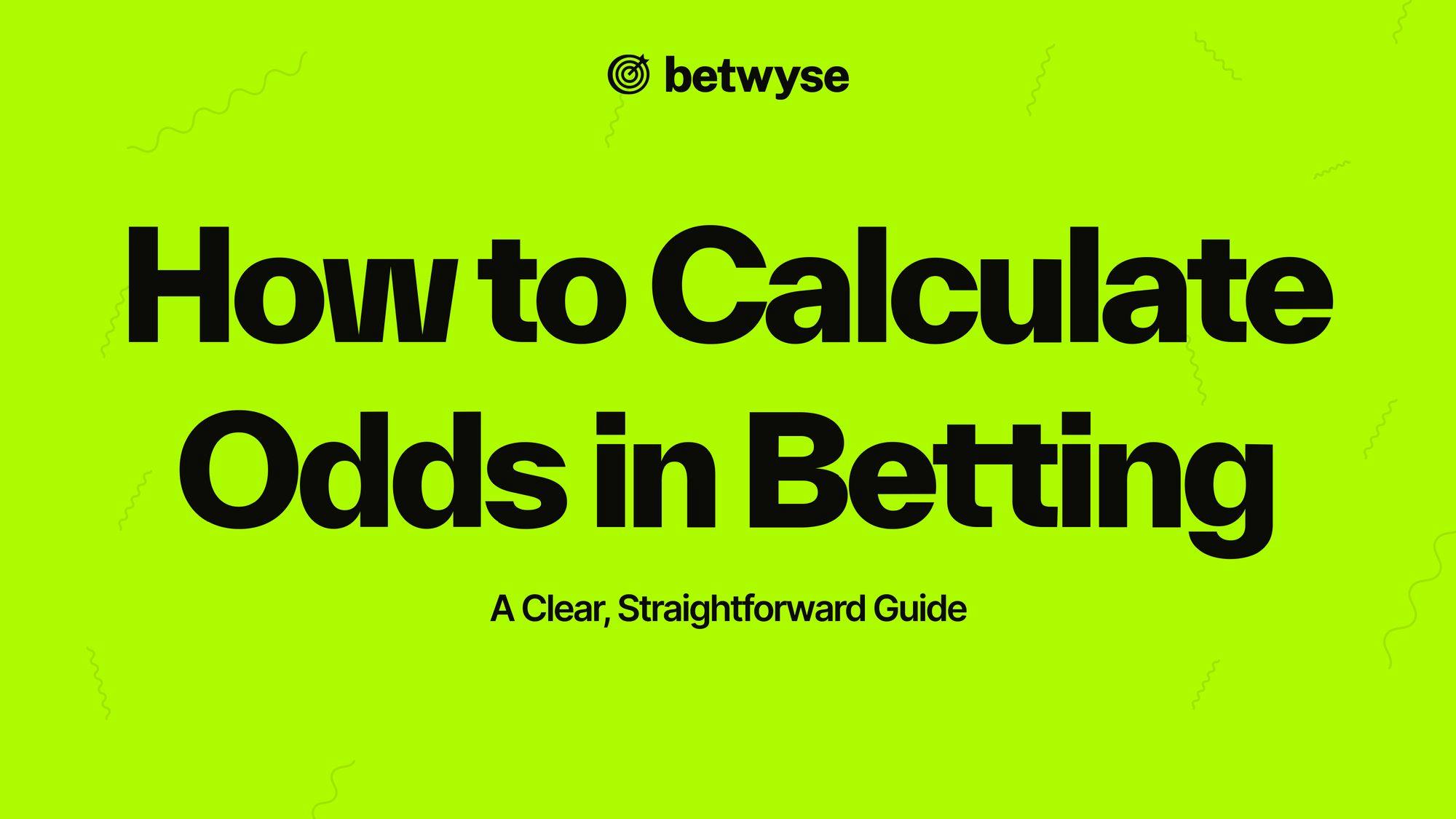Betting on sports and other events can be an exciting and lucrative pastime. For many people, though, the process of calculating odds may seem like a daunting task. We're here to help make sense of it all and ensure anyone can confidently place their bets armed with the proper knowledge.
It's essential to understand that betting odds represent the implied probability of a particular outcome occurring. They allow us to determine the potential return on a bet while also helping us gauge the chances of an event's occurrence. This article explores the basics of calculating odds, working with different formats such as fractional, decimal, and money line, and demonstrating how to apply these concepts in real-life betting situations.
By the end of this article, you'll have a solid grasp of calculating odds in various betting scenarios. Whether you're just getting into the betting world or already have some experience, our guide will be valuable in making informed decisions about your wagers.
Understanding Betting Odds
In the betting world, odds are a crucial component that helps us determine the probability of an event occurring and the potential payout for a winning wager. They are the foundation for any bet and enable us to make informed decisions when placing wagers in a sportsbook.
There are several formats in which betting odds are presented, such as fractional, decimal, and American. Each format expresses the same information, just in a different way. We'll briefly explain each of these formats and how to interpret them:
- Fractional odds are commonly used in the UK and Ireland, represented by two numbers separated by a slash, like 5/1 or 10/3. To calculate the potential winnings and profit from fractional odds, we multiply our stake by the fraction. For example, if we bet $10 on 5/1 odds, we would win $50 (5 times the $10 stake) and receive a total payout of $60, including the initial $10 stake.
- Decimal odds are widely used in Europe, Australia, and Canada, and they are represented as a single decimal number, such as 1.50 or 3.75. To find out our potential winnings from decimal odds, we multiply our stake by the odds. For instance, if we bet $10 on odds of 1.50, our potential winnings would be $15 (the $10 stake multiplied by 1.50), with a profit of $5.
- American odds can be positive or negative, popular in the United States. Positive odds display the amount we would win with a $100 wager, whereas negative odds show how much we need to bet to win $100. For example, if we have +200 odds, a $100 wager would win $200, while -200 odds would require us to bet $200 to win $100.
When considering a bet, it's essential to understand the implied probability derived from the given odds. Implied probability can be found in every betting market and helps us determine the likelihood of a given outcome. To calculate implied probability using fractional odds, we can use the following equation:
Implied Probability = (Denominator / (Denominator + Numerator)) × 100
For decimal and American odds, the formulas are slightly different, as shown below:
Implied Probability (Decimal) = (1 / Decimal Odds) × 100
Implied Probability (American) = (100 / (American Odds + 100)) × 100 (for positive odds)
Implied Probability (American) = (-American Odds / (-American Odds + 100)) × 100 (for negative odds)
By understanding betting odds and their various formats, we can make better decisions when placing bets and increase our chances of reaping the rewards from gambling. Remember that odds represent probability and not a guarantee of the outcome, so always bet responsibly and within your means.
Different Types of Odds
Fractional Odds
Fractional odds are commonly used in the United Kingdom and Ireland. These odds are represented as a fraction, such as 5/1 or 10/3. We can quickly see how much we stand to win relative to our initial stake in this format. To calculate potential winnings, we multiply the stake by the odds. For example, if we bet $10 on a horse with 5/1 odds, we would win $50 ($10 x 5). Our total return would be $60, as we also get our original $10 stake back.
- Example: Odds = 5/1
- Calculation: Stake x Odds
- Potential Winnings: $10 x 5 = $50
- Total Return: $50 + $10 (stake) = $60
Decimal Odds
Decimal odds are popular in Europe, Australia, and Canada and are often considered easier to understand. These odds are displayed as decimals, such as 2.00 or 3.50. To calculate our possible winnings, we multiply our stake by the odds. Our total return includes both our initial stake and our winnings. For example, if we place a $10 bet on a team with 2.00 odds, our total return would be $20 ($10 x 2.00), resulting in a $10 profit.
- Example: Odds = 2.00
- Calculation: Stake x Odds
- Total Return: $10 x 2.00 = $20
- Potential Winnings: $20 - $10 (stake) = $10
American Odds
Also known as money line odds, the American odds are prevalent in the United States. These odds can be either positive or negative numbers. Positive odds represent the potential profit from a $100 stake. In contrast, negative odds indicate the amount we must stake to win $100.
For example, if we bet $100 on a team with +200 odds, our potential winnings would be $200, with a total return of $300 ($200 + $100 stake). On the other hand, if we bet on a team with -150 odds, we would need to wager $150 to win $100, making our total return $250 ($100 + $150 stake).
- Positive Odds: +200
- Calculation: Stake x (Odds / 100)
- Potential Winnings: $100 x (200 / 100) = $200
- Total Return: $200 + $100 (stake) = $300
- Negative Odds: -150
- Calculation: Stake / (Odds / 100)
- Potential Winnings: $150 / (150 / 100) = $100
- Total Return: $100 + $150 (stake) = $250
How to Calculate Odds
Calculating Fractional Odds
Fractional odds are common in the UK and several other countries. To calculate them, we can use the following formula, where a/b represents the odds in fraction format:
Probability (%) = b / (a + b) * 100
For example, if we have odds of 3/1 (read as "three to one"), the implied probability would be:
Probability (%) = 1 / (3 + 1) * 100 = 25%
This means there is a 25% chance of the event occurring according to the odds.
Calculating Decimal Odds
Decimal odds are popular in Europe and Australia. To calculate the implied probability, we can use this formula, where D represents the decimal odds:
Probability (%) = 1 / D * 100
For example, if we have decimal odds of 4.0, the implied probability would be:
Probability (%) = 1 / 4.0 * 100 = 25%
Calculating American Odds
American odds are widely used in the United States. They come in two forms: plus odds (+) and minus odds (-). The formulas for calculating the implied probability are different for each.
Plus Odds (+):
Probability (%) = 100 / (Odds + 100) * 100
For example, if we have American odds of +300, the implied probability is:
Probability (%) = 100 / (300 + 100) = 25%
Minus Odds (-):
Probability (%) = Odds / (Odds + 100) * 100
For example, if we have American odds of -200, the implied probability is:
Probability (%) = 200 / (200 + 100) = 66.67%
We become more knowledgeable bettors by understanding how to calculate odds with different formats. Remember, the actual probability of an event occurring may differ from the implied probability of the odds. Consistently exercise discretion and consider other factors before placing bets.
How Bookmakers Set Odds
As bookmakers, setting odds is one of our most crucial tasks. Our goal is to create odds that accurately reflect the probability of an event occurring while also ensuring we maintain a profitable margin. In this section, we will discuss the steps involved in setting odds and how we balance profitability and fairness to our users.
First, we gather relevant data and analyze it to determine the probability of the event happening. We consider various factors, such as team or player performance, external conditions, and historical trends. Once we've assessed these factors, we can assign a percentage probability to each possible outcome.
Next, we factor in our desired overground or vigorish profit margin. We adjust the odds slightly to ensure our business remains profitable in the long run, regardless of the event's outcome. The overground represents the difference between the odds we offer and the actual odds of the event. It is essential to strike a balance and set the margin high enough, as that could push users away from our site due to uncompetitive odds.
In some cases, such as spread betting, we may provide different odds for buyers and sellers, effectively creating a spread between the two. This allows us to profit from the difference and manage our risk exposure more efficiently.
As the event approaches, we continuously monitor betting activity and adjust the odds accordingly. Suppose we notice a heavy influx of bets on one side. In that case, we may alter the odds to minimize our potential losses and encourage more balanced betting. This process of updating odds is commonly known as line movement.
Our approach may vary depending on the event's nature and the level of information available. However, it's essential to balance attracting users to our site with competitive odds and ensure we continue operating as a profitable business.
How to Calculate Payout
Calculating Payout with Fractional Odds
We first need to understand the odds format to calculate the payout using fractional odds. Fractional odds are represented by a fraction (e.g., 4/1 or 7/2) and show the potential profit from a successful bet compared to the initial stake. To calculate the payout, follow these steps:
- Divide the first number (numerator) by the second number (denominator)
- Multiply the result by your bet amount
- Add your original bet amount to get the total payout
For example, if we have odds of 4/1 and a bet amount of $100, the payout calculation would be:
(4 / 1) * $100 = $400 (profit)
$400 + $100 = $500 (total payout)
Calculating Payout with Decimal Odds
Decimal odds represent the total payout from a winning bet, including the original stake. To calculate the payout using decimal odds, follow these simple steps:
- Multiply the decimal odds by your bet amount
- The result is the total payout
For example, if we have decimal odds of 1.5 and a bet amount of $100, the payout calculation would be:
1.5 * $100 = $150 (total payout)
Calculating Payout with American Odds
American odds use positive (+) and negative (-) figures to indicate the payout for a winning bet. To calculate the payout using American odds, we follow different methods for positive and negative odds.
- Positive American Odds: Divide the odds by 100 and multiply by your bet amount. Add your original bet amount to get the total payout.
- For example, if we have odds of +200 and a bet amount of $100, the payout calculation would be:
- (200 / 100) * $100 = $200 (profit)
- $200 + $100 = $300 (total payout)
- Negative American Odds: Divide 100 by the odds (without the minus sign) and multiply by your bet amount. Add your original bet amount to get the total payout.
- For example, if we have odds of -150 and a bet amount of $100, the payout calculation would be:
- (100 / 150) * $100 = $66.67 (profit)
- $66.67 + $100 = $166.67 (total payout)
By understanding these three methods of calculating payouts in betting, we can make informed decisions when placing bets and better understand the potential returns.
Predicting Outcomes with Odds
Understanding Underdogs and Favorites
In the betting world, there are usually two main types of competitors – the favorites and the underdogs. A favorite is a competitor that is expected to win. At the same time, an underdog is a competitor expected to lose. The odds ratio accounts for the difference in skill or ability between these two competitors, allowing us to determine the implied win probability for each competitor.
When calculating odds, we must factor in the probability of winning and losing for both the favorite and the underdog. By doing so, we can provide bettors with a more accurate representation of each competitor's likelihood of success in a given event.
Heads Vs. Tails Probability
Let's consider the classic example of a coin toss - a scenario with only two possible outcomes: heads and tails. In this case, the probability of the coin landing on heads or tails is equal, as there's a 50% chance for each outcome. Here, the odds ratio would be 1:1, indicating that the implied win probability for each side is the same.
However, in most betting situations, the odds ratio and implied win probabilities will differ for each competitor, as one is typically favored over another. This is illustrated in the following table, where the odds ratio varies depending on the scenario.
Scenario Odds Ratio Implied Win Probability (Favorite) Implied Win Probability (Underdog)
A 2.0:1.0 66.67% 33.33%
B 3.0:1.0 75.00% 25.00%
To better understand this concept, let's look at the probability of winning and losing for each side in these scenarios.
Probability of Winning Vs. Losing
Knowing the difference between odds and probability is essential when analyzing the odds ratio. While odds represent the ratio of one outcome to another, the probability quantifies how likely an event is to occur.
For example, in Scenario A above, the odds ratio for the favorite is 2:1 - meaning that there would be one unsuccessful outcome for every two successful outcomes. This results in an implied win probability of 66.67% for the favorite and 33.33% for the underdog.
To make informed betting decisions, we should consider these implied win probabilities in the context of other factors, such as the competitors' historical performance, form, and other relevant variables.
Understanding and applying these concepts can improve our ability to predict outcomes and make more educated picks in betting situations.
Conclusion
In this article, we have shown you how to calculate odds in betting. We have provided clear and concise information to help you make informed decisions when placing bets. We have used a confident, knowledgeable, neutral, and transparent tone to provide a straightforward guide to calculating odds.
We have explained various odds formats, such as fractional, decimal, and money line, and demonstrated how to convert between them. Additionally, we have touched upon implied probability and how it can be used to evaluate the fairness of offered odds. This knowledge empowers you to gauge the value of your bets, enabling you to make smarter decisions.
It is essential to remember that betting should always be approached responsibly and with discipline. We encourage you to apply the understanding gained from this article to help you make well-informed bets. And as with any skill, practice makes perfect – the more you calculate odds and analyze betting opportunities, the better you will become at it.
Thank you for reading our guide on calculating odds in betting. We hope you found the information helpful and that it enhances your betting experience. Good luck, and happy betting!



